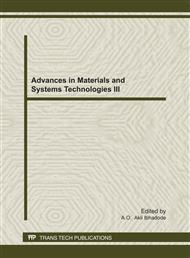[1]
Marie de Lazzer, Positioning System for an Array of Solar Panels ( M. Eng Thesis ( Unpublished). University of Botswana and Ecoles de Saint Cyr, France, 2005).
Google Scholar
[2]
J. T. Agee, M. de Lazzer an M. K. Yanev, "A Pole cancellation strategy for stabilising a 3KW solar power platform. Int. Conf. Power and Energy Systems(EuroPES 2006), Rhodes, Greece. June 26-28.
Google Scholar
[3]
J. T. Agee, A. A. Jimoh (2007) Feedback linearised Control of a Solar Power Platform. IEEE Africon 2007. Namibia.
DOI: 10.1109/afrcon.2007.4401568
Google Scholar
[4]
L. Borello, P. Maggiore and M. d. L. Della Vedova. Dry Friction Acting on Hydraulic Motors and Control Valves : Dynamic Behaviour of Flight Controls, XX Congresso Nazionale AIDAA, Milano, Italy. (2009).
Google Scholar
[5]
C. Canudas de Wit, H. Olsson, K. J. Astrom and P. Lischinsky, A New Model for Control of Systems with Friction, IEEE Transactions on Automatic Control, vol. 40, no. 3, March (1995).
DOI: 10.1109/9.376053
Google Scholar
[6]
J.J. Choi, S. i. Han and J. S. Kim, Development of a Novel Dynamic Friction Model and Precise Tracking Control Using Adaptive Back-Stepping Sliding Mode Controller, Mechatronics, vol. 16, 2006 pp.97-104.
DOI: 10.1016/j.mechatronics.2005.10.004
Google Scholar
[7]
V. Lampaert, J. Swevers and F. Al-bender , Experimetal Comparison of Different Friction Models for Accurate Low-Velocity Tracking, Proceedings of the 10th Mediterrannean Conference on Control and Automation (MED2002), Lisbon, Portugal, July 9-12, (2002).
Google Scholar
[8]
H. Olsson, K. J. Astrom, C. Canudas de Wit, M. Gafvert, P. Lischinsky, Friction models and friction compensation, European Journal of Control. Vol V, (1998), 176-195.
DOI: 10.1016/s0947-3580(98)70113-x
Google Scholar
[9]
I. Pazdera, Friction models in servodrives, Proceedings of the Sbornik praci Konnference a Souteze Student EEICT200, (1998).
Google Scholar
[10]
C. Makkar, W. E. Dixon, W. G. Sawyer and G. Hu, A New Continuously Differentiable Friction Model for Control Systems Design, Proceedings of the 2005 IEEE/ASME International Conference on Advanced Intelligent Mechatronics, Monterey, California, USA, 24-28. 2005, pp.600-605.
DOI: 10.1109/aim.2005.1511048
Google Scholar
[11]
B. C. Kuo & F. Golnaraghi, Automatic Control Systems (eight edition, John Wiley and Sons, Inc., 2003).
Google Scholar



